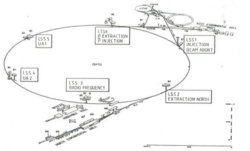Bob
Have a question related to this hub?
Alice
Got something to say related to this hub?
Share it here.
 | |
| Key SppS Experiments | |
|---|---|
| UA1 | Underground Area 1 |
| UA2 | Underground Area 2 |
| UA4 | Underground Area 4 |
| UA5 | Underground Area 5 |
| SppS pre-accelerators | |
| PS | Proton Synchrotron |
| AA | Antiproton Accumulator |
The Underground Area 3 (UA3) experiment was a high-energy physics experiment at the Proton-Antiproton Collider (SppS), a modification of the Super Proton Synchrotron (SPS), at CERN. The experiment ran from 1978 to 1988 with the objective of searching for magnetic monopoles.[1] No evidence for magnetic monopoles was found by the UA3 experiment.[2]

The experiment shares the same intersection region used as the UA1 colliding experiment, and looked for expected high ionisation of magnetic monopole in plastic detectors.[3] The beam pipe was a stainless steel corrugated cylinder, with 0.2 mm thickness.[4]
Plastic detectors were used as they are best suited to the chemically etched tracks left by the ionising particles, and they resist high temperatures during baking.[5][4] The plastic detectors used were 125μm thick kapton foils. The foils were placed inside of the vacuum chamber and around the central track detector for the UA1.[6] Three cylindrical and four transverse layers of detectors were placed between three chambers: two forward chambers and a central chamber. This covered the maximum solid angle possible.[5]
Holes etched along a monopole track were determined using diffusion of a gas or dye through the holes, followed by a chemical reaction. The ionisation rates of magnetic monopoles were predicted to be very high due to their short range.[5]